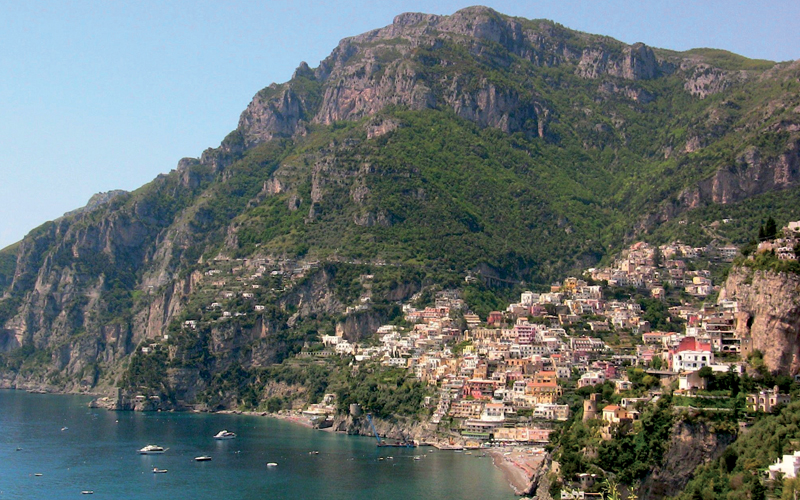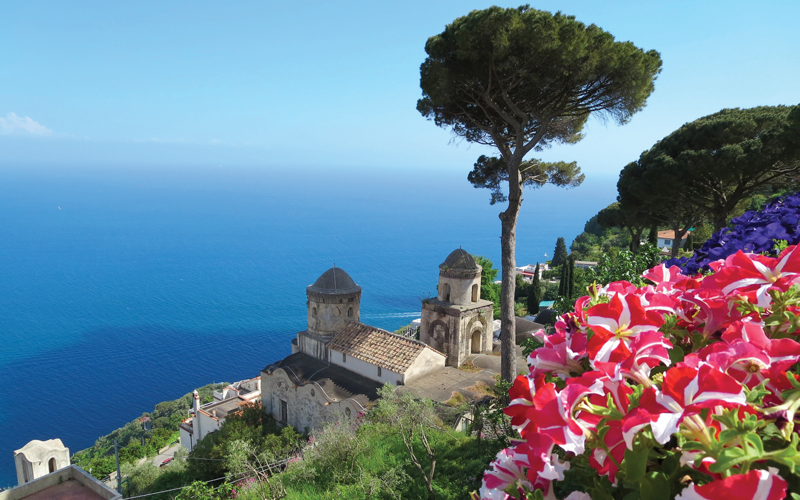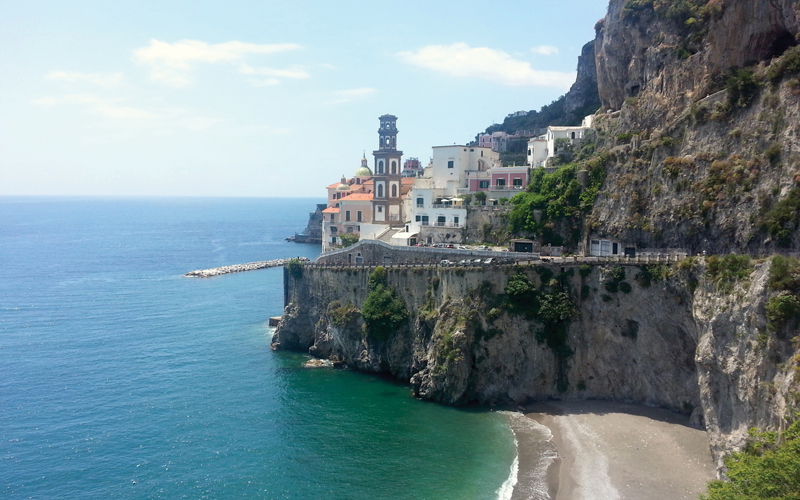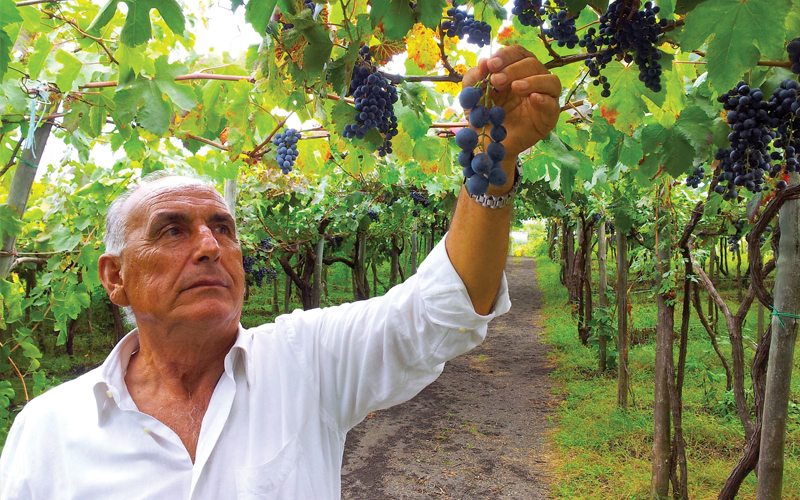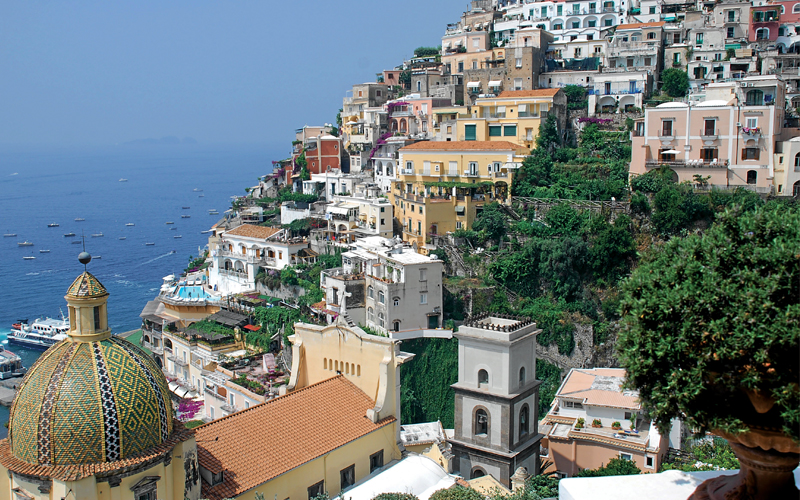It appeared as if the strips of light coming through my window shutters were gently playing with the soft texture of my bed’s cool white silky sheets. As I gazed at the glow on my skin, I took in a deep breath and slowly woke up to the new day. A good stretch and I jolted up onto my feet, moving towards the sunshine gleaming through my balcony. As I opened the door, a fresh sea breeze came sweeping in, filling the room with scents of lemons, fresh flowers, and unbound exhilaration.
There he was in front of me, across the Bay of Naples, the breathtakingly beautiful, ominous, and fascinatingly threatening Mount Vesuvius, whose fatal night’s eruption covered the entire ancient Roman cities of Pompeii and Herculaneum with enough ash and debris to hide them from history for sixteen hundred years. An intense aroma of freshly baked pastries made its way up the staircase and was now knocking on my door. It was time for me to get out and explore this piece of paradise called the Amalfi Coast.
As much as I love to be independent when traveling, not feeling restricted by sadistic schedules and exhausting activities, this time, I put my trust in a specialist. Her name is Nada Vergili, owner of Nada’s Italy (nadasitaly.com), and she promised I would “feel like a local” and have authentic, intimate experience in Italy. She connected me with Simona Strino Normand, a native from Catania, Sicily, who has been in the travel industry for over 15 years and would be my Italy expert taking care of all the time-consuming details. Simona and Nada share a deep visceral passion for Italy and are equally committed to providing their clients with unique high-level travel experiences, to make them feel part of the culture, history, and lifestyle.
Knowing I would be here for only a few days and needed a central location to take daytrips from, Simona booked me in the luxurious Pompeii suite at the Hotel Bellevue Sirene in the heart of Sorrento, a bustling town full of colors, sounds, and spectacular views from its dramatic cliffs overlooking the Bay of Naples. Sorrento is the perfect place to explore the Amalfi Coast, as it is connected to surrounding hot spots easily reachable by car, boat, bus, and train.
As I walk into the lobby, a smiling woman in her mid-40’s with bright green eyes and long dark lashes greets me. She says, “My name is Margherita, just like the pizza!” and giggles. It turns out, Margherita has an MA in Art History and PhD in Archeology. She enthusiastically says, “I am your local guide and I’ll make sure you have a wonderful stay here.” Whether it’s Margherita’s infectious laughter or her carefree attitude, I feel like I already have made a friend. She says “We have a full day ahead of us. We’re going to explore the art, history, and food of Sorrento, then we’ll discover how Romans lived in Pompeii before the eruption, and after we get sad, we’ll get happy again at a winery on the volcano!”
She whisks me away and we begin our walk through the streets, sites, and churches of Sorrento. After various stops to introduce me to local pastries, candy, and liqueurs, we slowly leave the souvenir and knick-knack shops behind us, making our way to a quieter part of town, tracing the cobbled stones along the old Via Cesarea. Margherita knocks on a door that is slightly open. There is no sign, no flashy window to attract tourists in. An older man with a worn-out leather apron comes to the door and lets us in. He is Maestro Giuseppe, a local artisan who has been carrying on the tradition of Intarsia Sorrentina (inlaid wood) for decades. Sorrento has been known for this craft since the 1600’s and still today exports exquisitely hand-made pieces ranging from tables, boxes, to framed artwork all over the world.
We continue our walk-through town and Margherita says “I’d love for you to try some local pizza. It’s delicious! But, I must tell you something before we go.” Of course, I’m intrigued. “Yes, what is it?” I answer. She says “Well, it’s a VERY local place… I mean, it’s not fancy, so if you want something upscale, this is not the place. But if you want great pizza, then it is!” Once again, her eagerness to share her culture combined with disarming candor demolishes any doubt or hesitation on my part. “Andiamo!” says Margherita as she shows me the way. We walk into a small pizzeria with long communal wood tables and prosciutto hanging from the ceiling. It is called Da Franco, basically a local institution. Don’t expect tablecloths here, but do expect groups of loud Italians, frazzled waiters, and incredibly amazing pizza.
A quick twenty-minute car ride gets us to the nearby archeological site of Pompeii, a city so large that its ancient ruins continue to be unearthed today. Margherita tells me “We are walking into the city as visitors and this is what we would have seen back then: you see this on the right? This was a shop, most likely a clothing store. This is what people wore back then. This is how the women dressed and wore their hair. Did you know they already died their hair back then?” Just as a masterful artist, she proceeds to paint mental pictures for me as we meandered across the remains of the city, I could almost see people moving in front of me, hearing the carts and horses’ hooves hitting the stone pavement, and imagining the grandeur of what Pompeii used to be at the height of its existence. Because of Margherita’s skills, I felt like history wasn’t just coming to life, I was a part of it.
On our way out, Margherita reminds me that not much has changed since ancient times, and just like the Romans enjoyed their wine and festivities, it was also time for us to make our way to the side of Mt. Vesuvius and begin to see the glass half full again.
We arrive at Sorrentino Vini, a boutique winery owned by the family of the same name. Antonio, a gentleman in his early 70’s, brings me a flower he just picked from the garden. He kisses me on both cheeks and says “Bellissima! Welcome! Do you like wine? I have some good wine for you!”
Antonio takes us on a walk through the vineyards, stopping by each row and explaining the various grape varietals they grow. “You see, this one’s called Per’e palummo in Neapolitan dialect, because the shape of the leaf reminds us of a dove’s foot. This other one is called Coda di Volpe, because the grape bunch is shaped like a fox tail.” He goes on talking about the history of the winery and then picks up a handful of soil next to the root of the grapevine. He leans towards me and says “You see this? Touch it, it’s volcanic pumice. This is from the eruption. There are tens of meters of this below our feet. There is no water here. We cannot irrigate our fields, the water drains and below is only sulphur. It is a miracle that these vines can grow here at all. This is the reason why our wine is so good.”
I can see his eyes glowing and I understand how deeply he is tied to this land, to its traditions, and how it shaped who he is and all the generations who have lived here. I feel honored that he is willing to share all this with me. We walk back to the farmhouse where his wife has prepared us a homemade dinner to go with the wine tasting. After a memorable meal crowning this day, I feel ready to go back to the hotel to rest and let it all sink in.
The next morning, I walk out of the lobby and I’m greeted by my personal driver, Umberto, who unbeknownst to me, is about to become my new best friend. Umberto, a man in his late thirties dressed sharply in an Italian tailored suit, says “Buongiorno Maddie! Sei pronta?” and then effortlessly switches to fluent English “Are you ready? Paradise is waiting for us!”. He opens the door to the spotless Mercedes and we’re off for the day.
As we begin driving the windy and narrow road that wraps like a boa constrictor around the steep mountains of the Amalfi Coast, Umberto asks “My nephew has a food stand on the way to Positano that has the best granita al limone, if you want to try it, it’s my treat!”. I didn’t know if this was part of the package, but I thought “In Rome, do as the Romans, right?” Umberto gets out, grabs a cup and hands it to me. I have concluded that calling it a lemon slushee would be too insulting to this tasty, tangy, sweet and sour treat made from fresh local lemons.
Once back in the car, Umberto continues onward to Positano, considered the jewel of the Amalfi Coast, or as the locals call it, La Costiera. As we get closer, the street winds down with an endless number of hairpin turns, and my mind has a hard time wrapping itself around the fact that I begin seeing the town almost vertical below me, as if we were flying over it. From a distance, Positano looks like a miniature village created with sugarcubes. The white-washed houses, built one on top of the other, braced onto the rock, remind me of Greek villages, such as Santorini. The bougainvillea is everywhere, climbing and clinging onto the walls of private villas, balconies, and canopies. The scent of lemon flowers fills the air as we drive by fertile terraces boasting rows upon rows of the citrus fruit tree.
Positano reminds me of one of those boxes where strings of beads are stored; to get the full picture of what’s in it, you must carefully sift through each hidden corner and tangled alleyway, with every section offering colors, secret overlooks, staircases and balconies with the perfect spot to take that epic photo you’re going to frame. After a little time to shop in Positano’s boutiques showcasing “moda Positano”, a coastal-chic style of clothing with free-flowing linen shirts for men and long, laced skirts and custom sandals for women, it’s time to continue South towards Amalfi, aka the “Queen” of La Costiera.
This seemingly small village of only about 5,000 residents was once a powerful maritime republic, a sort of small kingdom, with a mighty commercial and political influence reaching all corners of the Mediterranean during the 10th and 11th centuries, trading the highly sought-after commodities of paper and silk.
After parking the car, Umberto comes up to meet me in the main Piazza of town to make sure everything is alright, but shows a sudden grin on his face and asks, “Would you like to try the gold of Amalfi?”. Taken over with curiosity, I follow him into an alley and then into a small shop, where the fragrant lemons can be smelled from one hundred yards away. There are dozens of jars stacked on shelves holding lemon peels steeped in alcohol, to be soon turned into one of Amalfi’s specialties: Limoncello, a sweet & intense liquor to be served chilled. The owner, Fabrizio, tells me that the real limoncello can only be made with the sfusato di Amalfi, an abnormally large lemon variety that grows on the mountains alongside the coast. Most locals make their own version at home, with each family recipe being “better than everyone else’s”. He also tells me that the bottles they sell have the same limoncello they make at home with only these four simple ingredients: lemon peel, sugar, water, alcohol…and nothing else. I could tell Fabrizio was very passionate about his limoncello and could have talked for hours, but there were only so many hours I had available and we needed to keep going.
Back in the car Umberto asks if I am hungry and of course I say “Si!”. He says he’d take me to a little restaurant that mostly locals go to, in the tiny village of San Giovanni a Pontone, just outside of Ravello, our next destination. As soon as we get there, Silvio, the owner, greets me with open arms, a big smile, and a loud “Buongiorno!” and walks me to my table, under the shade of a pergola, with the most striking view of the coastline. Suddenly, a parade of dishes unfolds before my eyes. Fresh homemade pasta scialatielli con zucchini, lemon risotto, oven-baked branzino with cherry tomatoes and black olives, among many other local dishes. And who could give up on the grand finale of a traditional pear & ricotta tart with side of limoncello? Not me.
As I enter the kitchen to thank the chef, I realize it’s Silvio’s wife who oversees all the food. I begin to realize it’s not just the sights that make people fall in love with Italy repeatedly, but also the people.
Once in Ravello, I decide to walk up to the gardens of Villa Cimbrone, about 20 minutes from the center of town. If there was ever a place that one could say “If I died now, I’d die happy.” this would be it. There are flowers everywhere, lining a long walkway with hanging wisteria, pine trees, palms, gazebos, secret hideaways, statues, and old stone benches to sit and contemplate life on… or perhaps my upcoming book about how I moved to Italy and started a new life.
On the drive back, Umberto tells me there is one more surprise. “Before I take you back, we’re going to have an Aperitivo on one of the area’s most scenic terraces”. I had a hard time believing that was even possible, given the fact that I had already witnessed some of the most beautiful views of my life. He pulls into the driveway of the Hotel San Pietro. Taking a short walk down a perfectly landscaped walkway, I knew I was entering a magical place. A wide terrace with tropical fruits and exotic flowers sprawled over a stunning view of Positano. This was the essence of La Dolce Vita.
My time here is up, but I am not complete. I know there is so much more to be discovered, so many more connections to be made. I feel as if I have found “my place”, feeling welcome, at home, at ease. So many unique and memorable experiences that I am excited to share with family and friends, but for now all I can say is Grazie.





